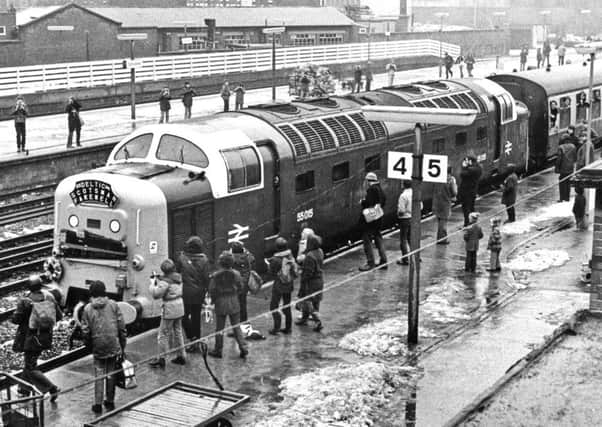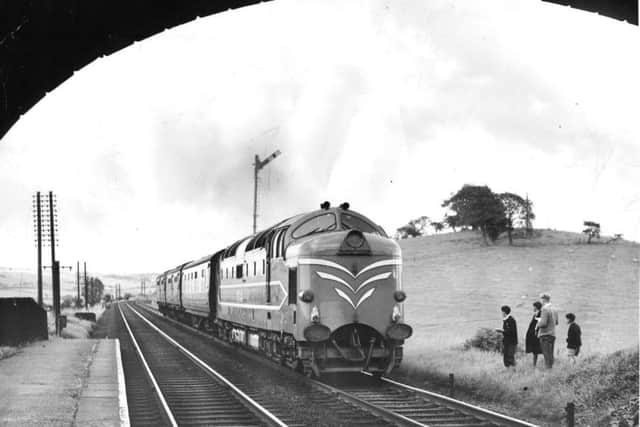Nostalgia on Tuesday: The Deltic story


A new fleet of diesels was to take over from the likes of Flying Scotsman and Mallard steam locomotives on the East Coast Main line express passenger services and amongst these classes were the ‘Deltics’.
The name relates to the locomotive power unit; there were two in each locomotive. Its configuration, an inverted triangle, is similar to an inverted Greek letter Delta. Developed in 1943 by D. Napier & Sons, the engine was constructed for use by the Admiralty in fast patrol craft. But the chairman of English Electric, later Lord Nelson of Stafford, saw its potential for use in a diesel electric locomotive.
Advertisement
Hide AdAdvertisement
Hide AdNapier & Son was absorbed by English Electric in 1942 and the later company’s Traction Division initially opposed housing the Deltic engine in a locomotive. They did not want its marine reputation tarnished by an expensive foray into rail traction.


The first Deltic was a prototype – built by English Electric. Coded DP1 (Diesel Prototype No.1) the name Deltic was adopted. It was built at Preston at a cost of about £250,000. Weighing around 100 tons and with 3300bhp, the locomotive was painted in light blue and cream and its two Napier Deltic engines roared. It was unveiled by Lord Nelson in October 1955.
Deltic began trial running on BR’s London Midland Region and was further tested on the Settle to Carlisle line between 1955 and 1957. After operating more passenger trains on the London Midland Region, mostly between Euston and Liverpool, the region’s mechanical and electrical engineer, J.F. Harrison, was not impressed. The LMR then turned away from diesel traction and concentrated on electrification of its lines.
Deltic then moved to BR’s Eastern Region in 1959. ER General Manager Gerard Fiennes had spotted the potential for these locomotives on the East Coast Main Line services and put forward a case to the British Transport Commission. Each one was to cost £156,000. The diesel electrics allocated to the ECML in the late 1950s were intended to replace steam but lacked sufficient power for the planned train timings. The powerful Deltic showed it could offer solutions and initially worked on services between King’s Cross and Doncaster.
Advertisement
Hide AdAdvertisement
Hide AdThe Yorkshire Post photographers took pictures of the prototype at Leeds, Wakefield, Gargrave and Skipton. Its high performance resulted in the British Transport Commission ordering 22 similar locomotives from English Electric for use on ECML express passenger services. They were delivered in 1961/2.


It was intended they would replace 55 steam locomotives. The Deltic prototype, out of gauge in some parts of the ECML, was withdrawn and donated in 1963 to the Science Museum.
The 22 production locomotives came with a service agreement, English Electric agreeing to maintain the power units for ten years. This involved Doncaster Works taking out and replacing engines when in need of repair and sending them to English Electric’s Vulcan Foundry Works at Newton-le-Willows. Afterwards, Doncaster carried out all engine repairs and heavy maintenance. Eventually becoming known as the ‘King of Diesels’, the locomotives were allocated to three depots – Finsbury Park, London, Gateshead and Haymarket, Edinburgh. They entered service with dark green on top and a narrower strip of lime green along the bottom. But by 1966, they began to be painted in corporate Rail Blue with yellow ends.
Names were taken from racehorses and regiments. The top speed of 100mph meant the Deltics knocked an hour off the schedule between London and Edinburgh – six hours for the 392 miles.
Advertisement
Hide AdAdvertisement
Hide AdWhen sections of the ECML were upgraded, timing on services was much improved. From 1978 when the High Speed Trains (HSTs) were introduced the Deltics began to work on secondary duties. Also around this time British Rail had a policy of not maintaining small non-standard fleets of locomotives, meaning the Deltics had a limited future. This encouraged fans to form the Deltic Preservation Society, aiming to raise funds to preserve a working Deltic locomotive.


The withdrawal of the Deltic fleet began in January 1980 and was completed by January 1982. The final Deltic-operated service was the 16.30 Aberdeen-York on December 31, 1981, arriving in York just before midnight. The last train was an enthusiast special, the Deltic Scotsman Farewell on January 2, 1982. During the previous 18 years they had clocked up 64 million miles on the King’s Cross to Edinburgh, Leeds and Hull routes.
During the locomotives’ farewell runs station staff had never seen such crowds. The final southbound run on January 2, 1982 was hauled by 55015 Tulyar. At York, the station was packed. At Doncaster,Tulyar departed nine minutes late amidst the army of enthusiasts. The farewell special arriving at King’s Cross made News at Ten.
This year the Deltic Preservation Society celebrates its 40th anniversary, a major achievement considering it relies on donations and volunteers, aided by the society’s members.
Among the preserved Deltics are:
55002 The Kings Own Yorkshire Light Infantry, claimed by the National Railway Museum and based at York.
55022 Royal Scots Grey and D9016 Gordon Highlander belong to Beaver Sports/Martin Walker.